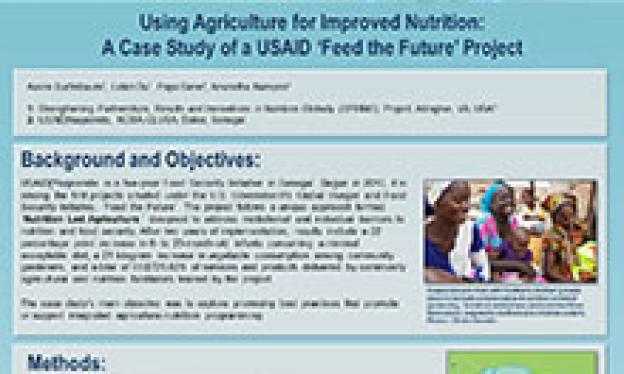Authors: Buchsbaum A; Du L; Narayan A; Sene P
Background and objectives: USAID|Yaajeende is a five-year Food Security Initiative in Senegal. Begun in 2010, it is among the first projects created under the U.S. Government’s Global Hunger and Food Security Initiative, ‘Feed the Future’. The project follows a unique approach termed ‘Nutrition Led Agriculture,’ designed to address institutional and individual barriers to nutrition and food security. After two years of implementation, results include a 22 percentage point increase in 6- to 23-month-old infants consuming a minimal acceptable diet, a 21 kilogram increase in vegetable consumption among community gardeners, and a total of US$729,628 of services and products delivered by community agricultural and nutrition facilitators trained by the project. The case study’s main objective was to explore promising best practices that promote or support integrated agriculture-nutrition programming.
Methods:
- Desk review of USAID|Yaajeende project documents.
- Week-long field visits to two of three project intervention zones in eastern Senegal (see
map). - Twenty-four key informant and group interviews (sixty-three individuals total) with
USAID Mission staff, government officials or employees, project staff, private sector
partners, and community members. - Review of responses for evidence of sustained personal or institutional relationships
with an emphasis on importance of linkages between agriculture and nutrition.
Results: The quotes below from different types of stakeholders are indicative of a shared understanding of the importance of using agriculture to achieve nutrition outcomes.
Community Level
"People here farm to eat. Now we're encouraging them to farm for nutrition."
-comment during group interview with community agriculture service providers
Project Level
"I like this one the best -- Diet Diversity -- because it is nutritional, but directly implicates agriculture."
-Papa Sène, NCBA-CLUSA Senior Technical Advisor, on performance indicators used in project reports
Government Level
"PlumpyNut is not the solution. The solution is agriculture."
-Aliou Sall, Ministry of Health Regional Director, Agency for Food, Nutrition and Child Survival
In addition to early nutrition outcomes seen in project documents, interviews with project, government, and community stakeholders revealed that USAID|Yaajeende project managers nurture a shared vision under their ‘Nutrition Led Agriculture‘ approach. Both project staff and community agents are heavily invested in their work and closely aligned with institutions and initiatives under the Ministries of Agriculture and Health. Community agents in particular are empowered to operate responsively to field-identified needs through mechanisms that engage both the public and private sectors.
Conclusion: The case study of USAID|Yaajeende shows that integration of agriculture and nutrition activities in development projects is greatly enhanced when:
- the thinking and the attitude adopted by project staff is firmly cross-sectoral;
- this vision is actively communicated to community and government partners, and within project staff;
- there is an emphasis on elaborating common goals among project staff and community partners, and;
- the project makes consistent use of coordinated workplans with government, private sector, and international entities.
